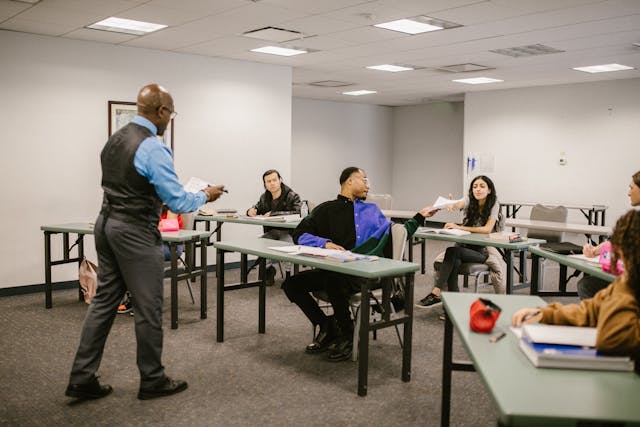Addressing the lack of funding for mental health in schools

More than half of public schools (52%) can’t provide mental health services to students who need them. In 2022, the Bipartisan Safer Communities Act (BSCA) was passed. Part of the act helps fund student mental health initiatives by increasing access to care and expanding school-based resources, such as social workers, counselors, and psychologists. Today, cuts to U.S. Department of Education programs and the expiration of short-term pandemic relief measures threaten to reduce that funding.
Lack of funding for mental health in schools doesn’t just mean fewer services. The effects extend to every aspect of school life, from academic success and emotional stability to an overall sense of safety and belonging. According to some studies, schools are the most likely place for students to receive mental health services. Funding cuts mean overwhelmed counselors, widened equity gaps, and unaddressed urgent crises.
If you’re faced with reduced funding for mental health in schools, there are ways you can protect students. Continue reading to learn more about causes, consequences, and solutions if your school or district is facing a pending funding shortage.
Why school mental health funding falls short
Even though we have clear evidence that successful school-based mental health programs help students thrive, access remains limited and uneven. The American School Counselor Association recommends a student-to-counselor ratio of 250-to-1. In many states, that ratio is more than double. In some cases, it’s more than 550-to-1. It’s impossible for one school psychologist to handle everything from daily stress to major crises across multiple campuses, but many are forced to try. In some districts, a single mental health professional is responsible for serving every student in the county.
In the past, schools have used BSCA and other school mental health grants to fund initiatives for violence prevention, social-emotional learning (SEL) programs, anti-bullying strategies, and to improve overall school climate. For example, New Jersey’s East Orange School District recently partnered with Montclair State University. Together, they used a Mental Health Service Professional (MHSP) Demonstration Grant to train school-based mental health providers and expand professional development. In Michigan, Elkton-Pigeon-Bay Port Laker Schools used funds from the Stronger Connections Grant Program (via the BSCA) to implement the district-wide Lion Heart Experience. Their efforts focus on student resilience and self-worth and support school culture, staff training, and students with mental health needs.
Almost all schools (97%) offer at least one mental health service, yet 70% say it’s not enough. High student-to-counselor ratios and funding cuts threaten the safety net many students rely on.
The impact of underfunded mental health services in schools
A lack of mental health funding in schools has devastating consequences. There’s the increased strain on mental health providers, academic and behavioral fallout, and growing inequities among low-income and rural student populations. The impact shows up everywhere, from counseling offices to classrooms, with high percentages of students being affected. Over half of public schools (56%) say that inadequate funding limits the services they can provide, while 58% report an increase in students who need mental healthcare.
Strain on school counselors and psychologists
A growing number of districts have counselor-to-student ratios that are far above recommended levels. School-based mental health professionals are stretched thin and experiencing burnout as they struggle to provide individualized care. They’re forced to set aside long-term wellness initiatives so they can address urgent safety concerns.
Academic and behavioral fallout
Poor student mental health is linked to lower academic performance and reduced attendance rates. It results in an uptick in disciplinary issues and an increased risk of dropout. Students with access to mental health services, however, are less likely to miss school, perform poorly, or face disciplinary action.
Additionally, research also suggests that students who don’t have access to mental health resources are twice as likely to feel persistently sad and hopeless, key risk factors for self-harm and disengagement in school.
Widening inequities
Reduced mental health funding in schools disproportionately affects some communities more than others. Students in rural or low-income districts, for example, typically have far fewer resources than those in wealthier, more suburban areas.
It appears that the schools with the greatest needs have the least support. Studies have found that Black, Latino, and low-income public school districts are less likely to have full-time counselors or psychologists on campus, with less bandwidth to provide mental health support. Students in this demographic also face other barriers, including lack of access to college counseling and insufficient mental health support.
Policies and initiatives addressing the gap
Despite the financial challenges many schools are facing, momentum continues to build around providing students with access to mental healthcare. Some districts have even launched independent initiatives, providing resources for peer support programs, trauma-informed faculty and staff training, after-school counseling, and other mental health services.
Today’s decision-makers are having to allocate resources more creatively, and their efforts are crucial, as temporary funding grants near expiration and cuts to federal programs are expected.
What schools and communities can do now
Studies show that lower student-to-counselor ratios are associated with higher graduation rates and fewer disciplinary issues. In short, prioritizing access to mental healthcare in schools is a win-win. There are many ways schools, districts, and communities can come together to advocate for change and support students. Their efforts can help ensure mental health services are available and reduce the burden so many school mental health professionals feel.
Partnering with telehealth providers
Telehealth can be a lifeline for students in need, especially for schools in rural areas or when in-person counselors aren’t available. There are several benefits to telehealth mental healthcare, including reduced wait times for care, tailored support for specific demographics, and a way to reduce stigma. One study even found that schools utilizing telehealth for mental health support saw a 29% reduction in absenteeism.
Platforms like Talkspace can offer accessible, secure, affordable therapy for both students and school staff.
Training teachers to identify early signs of distress
Teachers are often the first ones to notice if a student is starting to withdraw or seems overwhelmed. Offering basic mental health training empowers faculty and staff to recognize red flags early on. It also ensures they know how to effectively use empathy before discipline.
To help teachers identify early signs of distress, schools can offer:
- Training and workshops on trauma-informed teaching
- Referral pathways to ensure students have easy access to counseling services
- Workshops that provide scripts for critical first conversations
- Universal screening tools and training, so teachers can learn to identify and respond to concerning trends
- Collaborative environments that include mental health teams, counselors, school nurses, administration, and social workers
- Resource guides that share what services are available and how to access them
- Peer support networks for educators and school staff who need help processing difficult situations relating to student mental health topics
“Teachers can check-in with students and make it a regular part of class. Teachers can ask students to rate mood or have a fill in the blank about how they are doing for all students. This normalizes the check-in. Then teachers can circle back to those students that need more of a conversation or other resources."
- Laura Magnuson, MA, MS, LAMFT, VP of Clinical Engagement
Applying for available federal or state mental health grants
Even if federal funding dries up, that doesn’t mean you shouldn’t seek other available resources for mental health services. There are organizations outside of federal programs, like the Substance Abuse and Mental Health Services Administration (SAMHSA), state agencies, and private foundations, that offer grants to expand mental health services in schools.
Designate a staff member or create a committee to research opportunities and track upcoming deadlines when there’s a lack of funding for mental health in schools. Work with local community partners who are dedicated to promoting student well-being and willing to share grant writing responsibilities or explore new opportunities.
Steps you can take to secure funding right now:
- Sign up for email updates and alerts from SAMHSA
- Check your state’s Department of Education website
- Build and nurture relationships with community mental health nonprofits
- Document specific needs and desired outcomes (Tip: Using concrete data, like absenteeism and discipline incident rates, can strengthen your cause)
Engaging parents and communities in mental health advocacy
Parents and other community members can be powerful allies for schools seeking mental health funding and support. Host mental health awareness nights or launch a parent advisory group to get started. Use your school’s communication channels to keep invested partners and parents up to date on the initiatives you’re working on.
Bridging the gap in school mental health
Lack of funding for mental health in schools is complex, but you have more power than you might realize. The first step is recognizing the systemic barriers your school is facing. Creative solutions, including telehealth and community partnerships, can help you gain traction. Together, you can work to close the gap and ensure students have access to mental health services at school.
If you’re ready to take the first step in implementing a flexible, evidence-based solution– like Talkspace’s online therapy for students– in your school, request a demo today. Learn how you can make mental healthcare accessible and affordable, without having to wait for grant money that may or may not arrive.






